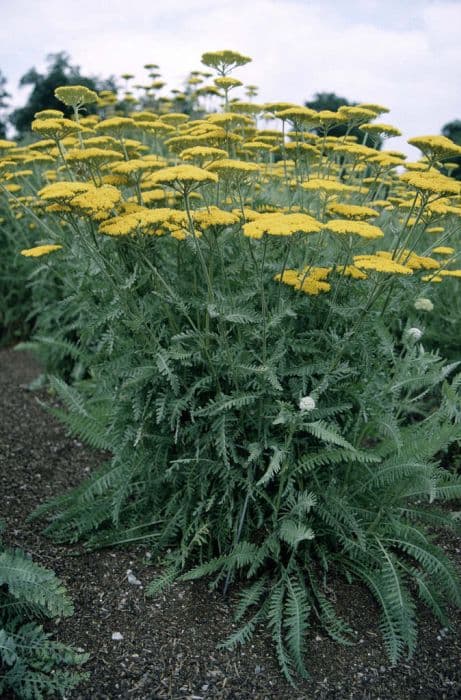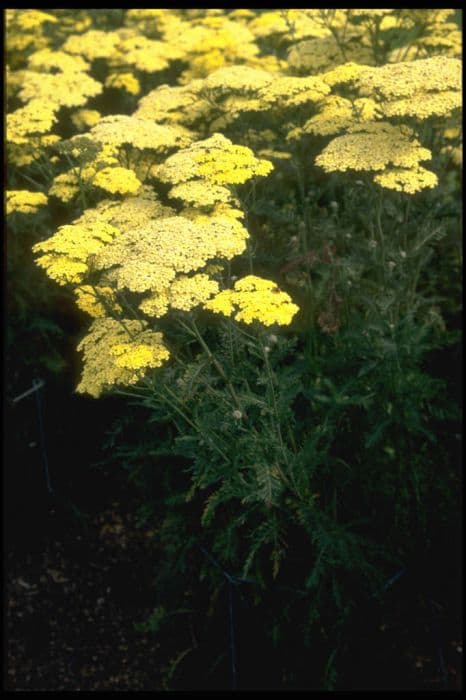Tickseed Coreopsis grandiflora 'Sunray'

ABOUT
The Coreopsis grandiflora 'Sunray', often known as Tickseed 'Sunray', is delightfully ornamental with its daisy-like flowers. These blooms feature a generous number of golden-yellow petals arranged in a circular pattern, creating a stunning resemblance to mini suns. Each flower is centered with a darker, sometimes brownish disc that holds a bounty of stamens, standing out against the petals’ vibrant hue. The leaves of the Tickseed 'Sunray' are slender and elongated, with a bright green color that forms a beautiful backdrop to the bright blossoms. They have a somewhat delicate texture with smooth edges, adding a fine visual texture to the plant's ensemble. As a whole, the Tickseed 'Sunray' displays a bushy profile dense with both foliage and blooms, which tend to proliferate and blanket the plant in a cheerful display of color, especially during its peak blooming season.
About this plant
 Names
NamesFamily
Asteraceae.
Synonyms
Tickseed, Large-flowered Tickseed, Pot of Gold.
Common names
Coreopsis grandiflora 'Sunray'
 Toxicity
ToxicityTo humans
Tickseed is generally considered non-toxic to humans. There is no significant evidence to suggest that ingesting any part of this plant would cause poisoning or adverse health effects in humans.
To pets
Tickseed is also generally considered non-toxic to pets. Ingesting parts of this plant should not cause poisoning or serious health issues in animals such as cats and dogs. However, as with any non-food plant, ingestion can sometimes lead to mild gastrointestinal upset due to the novelty to the pet's digestive system.
 Characteristics
CharacteristicsLife cycle
Perennials
Foliage type
Deciduous
Color of leaves
Green
Flower color
Yellow
Height
1-3 feet (30-91 cm)
Spread
1-2 feet (30-61 cm)
Plant type
Herb
Hardiness zones
4-9
Native area
North America
Benefits
 General Benefits
General Benefits- Low maintenance: Coreopsis grandiflora 'Sunray' is easy to care for and does not require a lot of attention or special treatment.
- Drought tolerant: Once established, they can withstand periods of drought, making them suitable for xeriscaping.
- Attracts pollinators: The flowers attract bees, butterflies, and other beneficial insects to the garden.
- Long blooming period: They produce showy yellow flowers that bloom from early summer to fall.
- Deer resistant: These plants tend to be resistant to deer, which can benefit gardeners who struggle with deer feeding on their plants.
- Easy to propagate: They can easily be propagated by seeds or division, allowing gardeners to expand their collection without additional cost.
- Versatile in landscaping: They can be used in borders, beds, and as cut flowers due to their vibrant color and long stems.
 Medical Properties
Medical PropertiesThis plant is not used for medical purposes.
 Air-purifying Qualities
Air-purifying QualitiesThis plant is not specifically known for air purifying qualities.
 Other Uses
Other Uses- Coreopsis grandiflora 'Sunray', commonly known as Tickseed, can be used as a natural dye for fabrics, providing shades of yellow and golden colors.
- The dried petals of Tickseed can be incorporated into potpourris for their vibrant color and to add bulk.
- Pressed flower art is another creative use for Tickseed, where the flowers can be carefully pressed and used in decorative arrangements under glass.
- Some gardeners use the seed heads of Tickseed in winter as natural bird feeders, attracting finches and other seed-eating birds.
- Tickseed can be used in educational settings to teach children about the lifecycle of plants and pollination, as it is attractive to bees and butterflies.
- The plant is sometimes used in companion planting to help deter certain pests from more vulnerable plants in the garden.
- Tickseed is culturally significant in some communities where it is used in celebrations and festivals as a symbol of cheerfulness.
- Photographers may use Tickseed gardens or fields as vibrant backdrops for portraiture and fine art photography due to their bright and sunny appearance.
- Insects such as ladybugs often find refuge in Tickseed plants, and the plants can be used to create a habitat for beneficial garden insects.
- Tickseed can play a role in xeriscaping, a landscaping method that reduces the need for irrigation, due to its drought-tolerant qualities.
Interesting Facts
 Feng Shui
Feng ShuiThe Tickseed is not used in Feng Shui practice.
 Zodiac Sign Compitability
Zodiac Sign CompitabilityThe Tickseed is not used in astrology practice.
 Plant Symbolism
Plant Symbolism- Cheerfulness: The bright yellow petals of the Tickseed often symbolize cheerfulness, as its sunny hue is commonly associated with happiness and positivity.
- Optimism: Tickseed can represent optimism, with its ability to grow in a variety of conditions, symbolizing hope and the expectation of good outcomes regardless of circumstances.
- Love: Some cultures associate Tickseed with love, perhaps due to its vibrant and enduring nature, which can be likened to the permanence of love in the face of challenges.
 Water
WaterTickseed prefers even moisture but can tolerate drought once established. During the growing season, water approximately once a week, supplying about 1 inch of water each time. Adjust the watering frequency based on rainfall, temperature, and soil conditions. In hot, dry spells, you may need to water twice a week. Ensure the soil is well-drained, as Tickseed does not like to sit in waterlogged soil.
 Light
LightTickseed thrives best in full sun, meaning it should receive at least 6 to 8 hours of direct sunlight daily. The ideal spot is an open area where the plant is exposed to unfiltered sunlight throughout the day. In areas with extremely hot summers, a bit of afternoon shade can be beneficial to prevent scorching.
 Temperature
TemperatureTickseed is hardy and can tolerate a wide range of temperatures. It grows best between 60 and 75 degrees Fahrenheit but can survive temperatures down to about -30 degrees Fahrenheit and up to 90 degrees Fahrenheit. Providing the right temperature for this cold-hardy perennial ensures it will return year after year.
 Pruning
PruningPrune Tickseed to promote vigorous growth and encourage prolific flowering. Deadhead spent blooms regularly to extend the blooming period. Cut back the foliage to a few inches above ground level in late fall or early spring for a tidy appearance and to stimulate new growth.
 Cleaning
CleaningAs needed
 Soil
SoilTickseed thrives in well-draining soil with a pH between 6.0 and 6.8. A mix of garden soil, compost, and coarse sand or perlite aids in drainage and fertility. Regular mulching helps maintain moisture levels without waterlogging.
 Repotting
RepottingTickseed, being a perennial, doesn't require frequent repotting. It should be divided or repotted every 2-3 years to maintain vigor and prevent overcrowding.
 Humidity & Misting
Humidity & MistingTickseed prefers average ambient humidity and does not require any special humidity conditions. It is adaptable to the humidity levels found in most garden environments.
 Suitable locations
Suitable locationsIndoor
Ensure bright light, minimal watering, and good airflow.
Outdoor
Plant in full sun, amend soil for drainage, mulch.
Hardiness zone
4-9 USDA
 Life cycle
Life cycleCoreopsis grandiflora 'Sunray', commonly known as large-flowered tickseed, begins its life cycle as a seed planted in well-draining soil in early spring after the danger of frost has passed. The seed germinates and grows into a seedling, developing true leaves and a root system. As the plant matures, it forms a clump of foliage and begins to produce flower stems topped with bright, showy yellow flowers typically in the late spring to early summer. Throughout the growing season, the tickseed will continue to bloom, especially if deadheaded to encourage additional flowers. In the fall, as temperatures drop, the plant will set seed before entering dormancy during the winter months. The next spring, the cycle can start again either from these new seeds or from the perennial root system, depending on the conditions and care provided.
 Propogation
PropogationPropogation time
Spring-Early Summer
Coreopsis grandiflora 'Sunray', commonly known as Tickseed, is best propagated by division. This method involves separating an established plant into smaller sections, each with its own root system. The most suitable time to divide Tickseed is in the spring or early fall when the plant is not in full bloom. To propagate by division, carefully dig up the plant and use a sharp spade or knife to cut the clump into sections. Ensure that each section has a portion of the root system and a few shoots. Replant the divisions at the same soil depth they were originally growing, spacing them about 12 to 18 inches apart (approximately 30 to 46 centimeters) to give them room to grow. Water them thoroughly after planting to help establish the new divisions.









